Europe is famous for its incredible gardens, many of which are filled with historic significance. From Monet’s Garden in Giverny to the Ljubljana Botanical Garden in Slovenia, there is an inexhaustible number of must-visit gardens in Europe.
Here, we list our top 6 choices.
1. MONET’S GARDEN, GIVERNY, FRANCE

Whether you are an art lover or not, you’ve likely heard of Claude Monet, one of the most famous painters in all of history.
Monet was one of the founders of the French Impressionist style of art, a movement that featured a unique style of painting scenes from nature, emphasizing the way in which changing light influenced the landscape.
One of Monet’s most famous pieces is Water Lilies, and this garden, in Giverny, France, which was also Monet’s home and personal garden, provided the artist with the inspiration for this painting.
The garden itself is split into two sections: the Clos Normand, and the Water Garden.
Clos Normand
Clos Normand is more of a cottage-style garden, and is located directly in front of Monet’s house. The flowers are the highlight of this garden, especially in the summer months when all of the blooms are at their best.
What about Monet’s house?
This two-storey building has now been turned into a museum, and is open for the public to explore.
The Water Garden
The second part of Monet’s Garden is the water garden, and, if you are familiar with the Water Lilies painting, then this is something that you will recognize as soon as you set your eyes on it.
The focal point of the garden is the pond, filled with, as you might have guessed, water lilies. The Japanese-style bridge from the painting is also present, and there are leafy trees that surround the pond and provide a sense of intimacy.
Getting to Monet’s Garden
Monet’s Garden is located just an hour away from Paris, making this a fantastic day-trip destination if you are already visiting the French capital. There are trains available every hour, as well as frequent river boat cruises, which are great if you want to combine your visit with a few other nearby destinations.
A Few Extra Tips:
- Arrive as early as you can in order to avoid the crowds. This will ensure that you are able to take photographs of the garden, and bridge, without too many people in the way, and will also save you from having to queue up at the entrance
- Tickets can be purchased online in advance, which will save you quite a bit of time on the day
- Give yourself at least an hour or two for exploring the gardens
2. KEW GARDENS, LONDON, ENGLAND
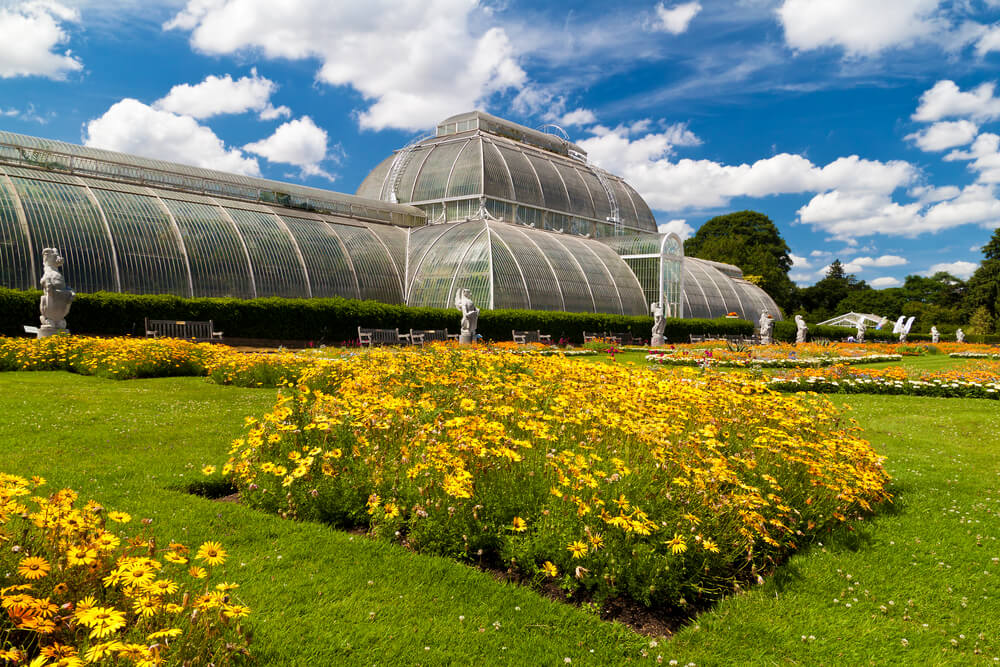
Also known as the Royal Botanic Gardens, Kew Gardens was originally founded in 1759, and is now a UNESCO World Heritage Site. Sprawled out for over 300 acres, Kew Gardens is considered to be one of the most important collections of living plants in the world.
Being such a large, expansive garden, there is so much to see here. These are a few of the highlights:
- The Alpine House – The Alpine House is one of the newest additions to Kew Gardens, and features plant displays that are frequently rotated. All of the plants that you will find here are capable of surviving at altitudes of up to 7000 feet, such as tulips, thymes, lavenders and some rare plants.
- The Palm House – The architecture of the Palm House won its designers numerous awards, and the interior is definitely a sight that needs to be seen. This glass house, which features 16,000 panes of glass, contains a range of different palm trees, including the rare double coconut palm.
- The Treetop Walkway – If you are visiting Kew Gardens with your family, then you will definitely not want to miss out on the Treetop Walkway, as this is something that will delight the whole family. The walkway extends for 660 feet over a gorgeous wooded area of the gardens, and, standing at 59 feet high, gives you a panoramic view of your surroundings.
There is so much else to see here, including the Temperate House, the Japanese Garden, the Orangery, and Kew Palace.
Want to explore the gardens but don’t want to miss out on any of its highlights?
There are guided walking tours available twice a day, as well as a motorized tour with a running commentary. This is great if you do not have the whole day to spare, as you can disembark at the specific stops around the park that you wish to explore further.
Here are a few extra tips to keep in mind when planning your visit:
- Clothing – dress warm but wear a jacket that is easy to remove, as certain areas, such as the Palm House and the Temperate House, can get uncomfortably warm. Also be sure to wear flat shoes, as some of the glasshouses contain grated floors
- Food – there are a number of eateries located around the gardens, as well as some wonderfully scenic picnic spots
- Garden Guides – if you are exploring the gardens on your own, pick up a garden guide at the entrance, as this will help you to understand more about all of the different features that you will see
3. ISOLA BELLA, VERBANIA, ITALY
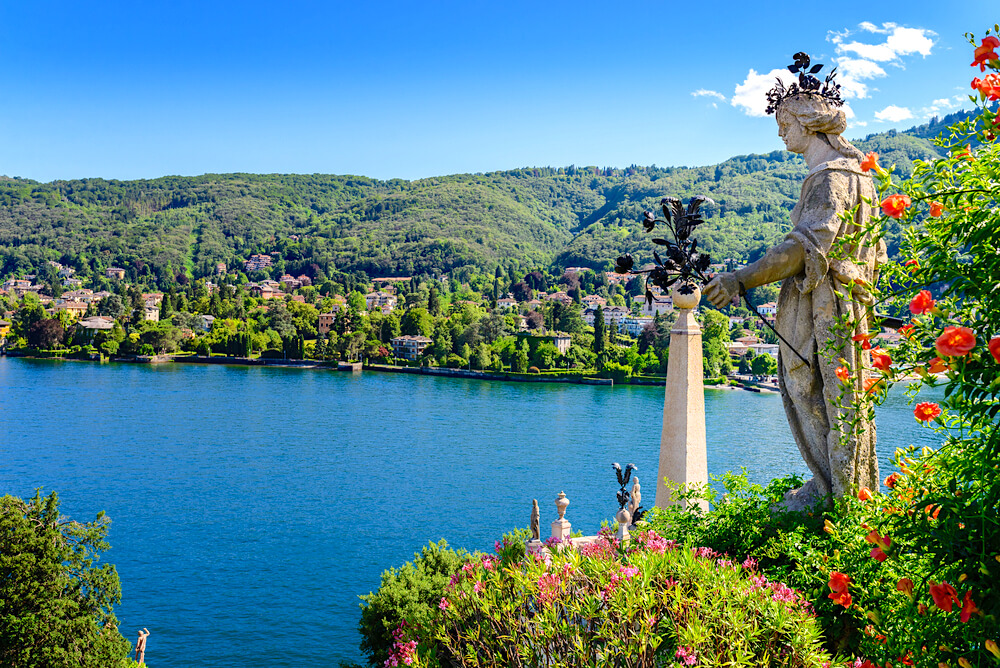
A small island situated in Lake Maggiore, Isola Bella means beautiful island in English. In the past, this rocky island used to be inhabited by local fisherman, but, in 1630, it was turned into an extraordinary garden by an aristocratic family.
This garden is immaculately landscaped, and, since it can only be reached by boat, has a truly rare sense of intimacy and seclusion. The terraces here feature a wide range of different colorful plants, such as azaleas, camellias and rhododendrons, as well as some rare tree species, such as the ancient camphor tree.
Of course, when visiting Isola Bella, having a look at the impressive Borromeo Palace is a must…
This is a grand, extravagant palace that lies at the heart of the island, and has only recently been opened to the public.
Just nearby to Isola Bella lies Isola Madra, the largest of all of the islands in Lake Maggiore.
Wondering what there is to do here?
Well, this is another island that features a one-of-a-kind garden, this time with more of a tropical feel, which is possible thanks to the island’s unique micro-climate. The plants that you will see here are much rarer than those on Isola Bella, with many of them being exotic and aromatic.
Getting to the Islands
As mentioned above, the only way to access these islands is by boat, and the best place to embark is the town of Stresa. From here, it takes just five minutes to reach Isola Bella, and then another 20 minutes or so to reach Isola Madra, with ticket packages available that make it easy to combine a trip to both.
4. LJUBLJANA BOTANICAL GARDEN, LJUBLJANA, SLOVENIA
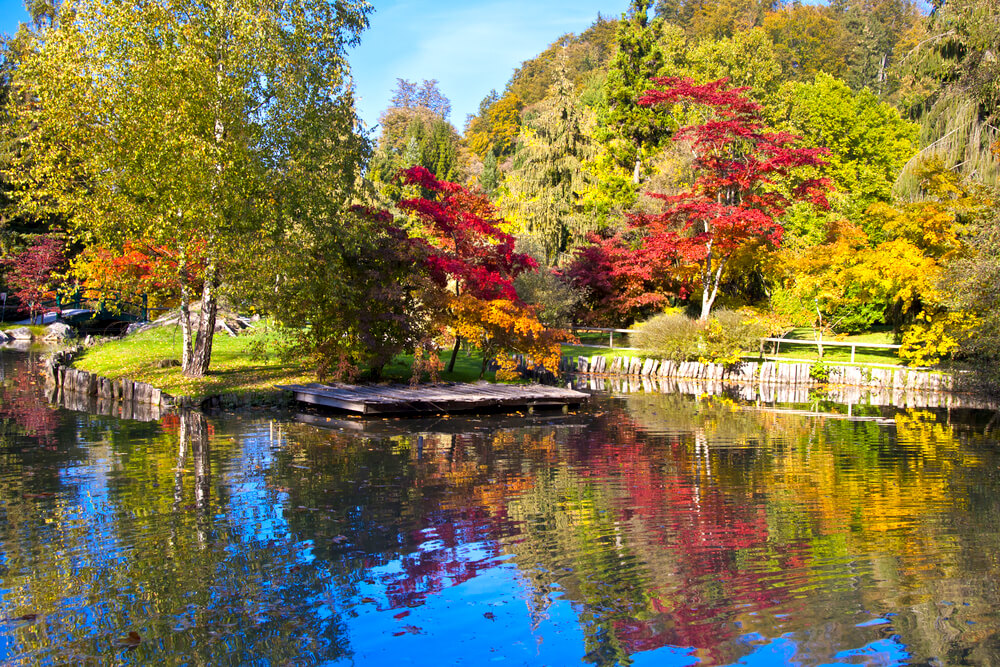
The oldest botanical garden in Southeastern Europe, the Ljubljana Botanical Garden was established in 1810, and has been running uninterruptedly since then.
The garden is not as large as some of the others mentioned in this list, stretching out for just under five acres, but it still manages to encompass such a wide variety of plants and trees, as well as other standout features.
Out of the 4500 plant species that you will find here, a third of them are native to Slovenia, while the others come from Europe and the rest of the world.
In addition to the magnificent diversity when it comes to plant species here, these are some of the other highlights of the Ljubljana Botanical Garden:
- The Tropical Glasshouse – There is a large glasshouse in the garden, which is home to around 400 plant species. These are native to different tropical areas around the world, and the interior of the glasshouse itself is reminiscent of a colorful, tropical jungle.
- The Arboretum – For those interested in seeing the different tree species at the garden, the arboretum is the area to head to first
- The Cultivation Section – A fascinating collection of plant beds that are used for research and propagation, which means starting off new plants before they are moved to other parts of the main garden
Being a Cultural Monument of National Importance, this is a garden that is open throughout the year, and the different plant collections here mean that there will always be something to see, no matter when you visit.
Wondering what else there is to do in the city of Ljubljana?
Plenty!
This is a beautiful, historic city, known for being one of the prettiest in Europe, and is filled with culture and heritage. From outdoor markets to a 16th century castle to a medieval Old Town, as well as world-class museums, restaurants and art galleries, this is the perfect city to head to for a European getaway.
5. PETRIN GARDENS, PRAGUE, CZECH REPUBLIC
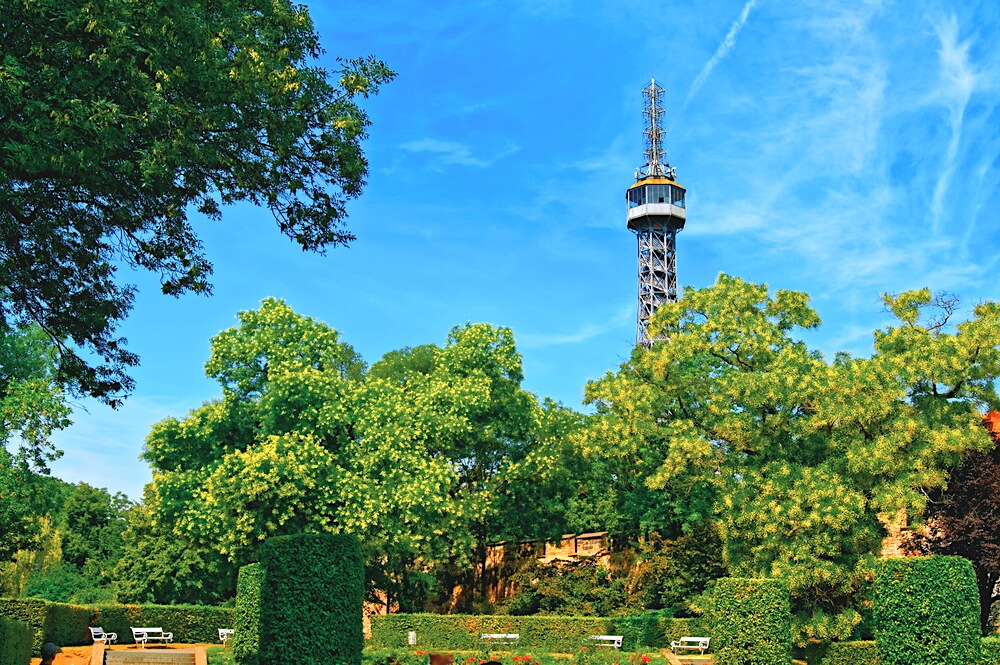
One of the largest gardens in Prague, stepping into the Petrin Gardens will make you feel as though you have gone back in time. With fragrant florals, whimsical details, and a sweeping view of Prague Castle in the distance, this is definitely one of the prettiest spots in the city.
Here are some of the can’t-miss spots in the garden:
- The Rose Garden – This is one of the highlights of Petrin Garden, as it is a six hectare garden that is filled with around 12,000 roses, of all sizes, shapes, colors and species
- Petrin Observation Tower – Built in 1891, this steel tower is a replica of the Eiffel Tower in Paris
- The Mirror Maze – If you are visiting the park with children, this maze, lined with mirrors, will keep them entertained for ages
- The Seminary Garden – This used to be a monastery garden, and is now filled with mature fruit trees
How to Get to Petrin Gardens
Since Petrin Gardens is sat on Petrin Hill, it is quite a steep hike for those who would prefer to walk.
Alternatively, you can take the funicular to the top, which adds to the old-fashioned charm that you will experience at the gardens.
A Bite to Eat
Many visitors tend to make a day out of visiting the Petrin Gardens, and while you can bring along a picnic, there is also a delicious restaurant halfway up the hill. The funicular stops here as well, making it extremely convenient.
Called Nebozizek Restaurant, guests can enjoy a view over all of Prague from the floor-to-ceiling windows, as well as food and wine to suit a range of budgets. From traditional Czech cuisine to international flavors, this is a restaurant that aims to please every guest, making it the perfect way to break up your day.
6. ALHAMBRA GARDENS, GRANADA, SPAIN
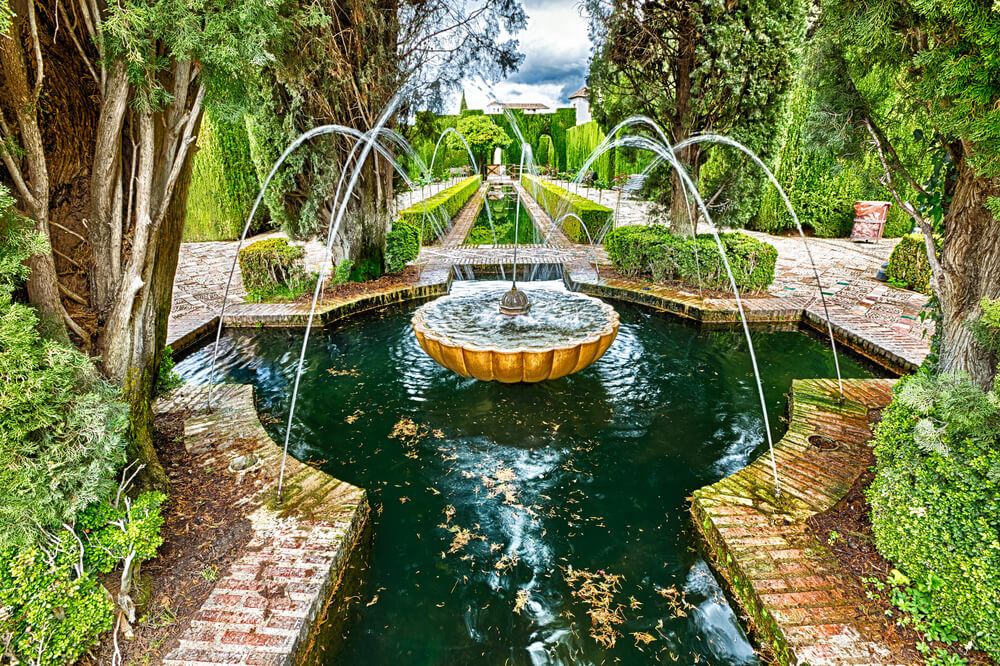
Located in Spain’s Sierra Nevada mountains, the Alhambra de Granada is an Arabic palace and fortress complex that is now a UNESCO World Heritage Site.
There are many buildings and areas within this historic complex, one of which is called Generalife, which refers to the main garden area.
Built in the 13th century, Generalife was a leisure spot for kings who wanted a quick escape from royal proceedings, and, while it has definitely changed quite a bit over the years, you can still feel such a sense of peace here.
These are some of the highlights of the Persian/Moorish-style garden:
- The Court of the Long Pond – with pavilions and arched galleries, this is one of the most photographed garden features in all of Europe
- The Court – features a Roman peristyle garden
- The Water Staircase – always a refreshing place to be, especially in the summer months
- The Low Gardens – traditional Muslim-style gardens
- The Soultana’s Court – an intimate court that features numerous water jets all around
The Alhambra itself is one of Spain’s most popular historic landmarks, so you will likely end up spending quite a few hours exploring the buildings, as well as the gardens.
How to Get There
Granada is quite an easy city to access, with everything from plane, train, car and bus options available.
From the center of Granada, you can then either walk to the Alhambra, or take a taxi or bus from Plaza Nueva.

Leave A Comment